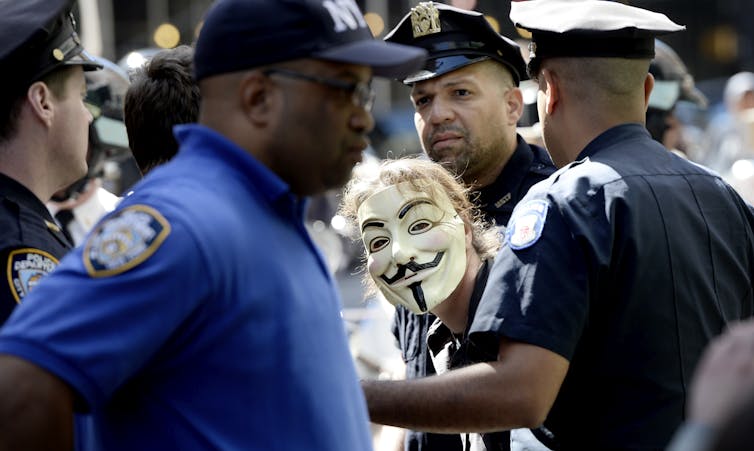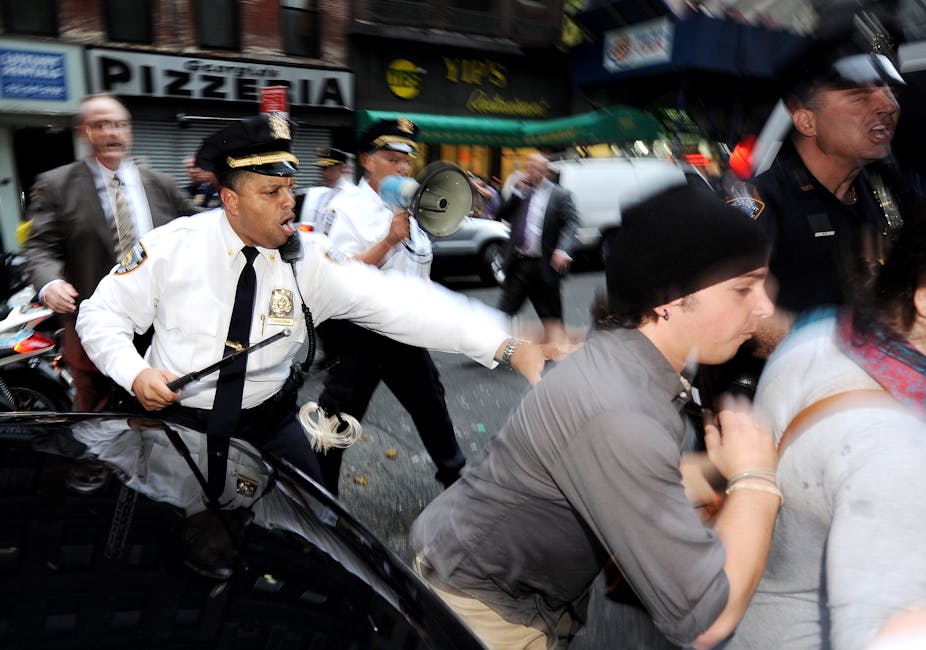It was a turning point in the story of a new kind of democracy – and how the state tried to snuff it out. In a coordinated show of force, state and federal authorities evicted Occupy Wall Street (OWS) and a number of similar camps across the US. It was November 15, 2011 – and five years on, the legacy of Occupy has some important lessons for us.
Occupy’s “we are the 99%” meme successfully placed debates about class inequality at the centre of political debate. The enthusiasm generated by Bernie Sanders in the US presidential primaries this year can be explained by this renewed political consciousness and the confidence of young Americans in particular. Hillary Clinton’s failure to win over this constituency partly explains her failure to defeat Donald Trump.
In the inevitable soul-searching to come, we need to think carefully about the nature of our political institutions and constitutions – and how they can serve all, not just the few, the powerful. In this respect, Occupy offers us a positive alternative to the status quo – a way of building bridges between diverse groups and empowering all.
The anarchists of Occupy created another way to constitutionalise – that is how to constitute ourselves as a political community – involving the people in all elements of decision making and identifying and combating domination in all its forms. This may strike you as ridiculous, but our research suggests that constitutionalising in this way is routine in anarchist groups such as Occupy, and has much to teach us all, especially in the new Age of Trump.
A new anarchism
Occupy put anarchism back on the political map. The anarchists of Occupy taught us that organisations can be structured differently and showed us that political movements don’t have to crystallise around political parties, businesses or even NGOs. Indeed, self-organisation stands as an important example of how anarchist ideas of non-domination and participatory democracy can also be constitutionalised. It is possible to identify five broad aspects of constitutionalising in Occupy.
Declarations and preambles: The Declaration of the Occupation of New York City was one of the first things to emerge from OWS. Much like the Preamble to the US Constitution, it invokes “one people, united” to bring the camp into existence. Occupy’s Declaration expressed commonly shared values, “constituting” the occupation as a group, the 99%, which included all those dominated by the unaccountable 1%.
Decision making: Occupy camps subsequently constituted themselves through participatory decision-making procedures. A General Assembly (GA) became the central decision-making body of each Occupy camp and decisions were made by consensus, by all. This is tricky because it gives everyone a veto or block, but it is designed to ensure that no one can be arbitrarily ignored or overruled. It can be, and was, modified to allow voting and to avoid one or a few individuals blocking a popular decision. Such modified consensus still demanded a high threshold – a 90% majority.
Occupy’s decision-making practices were as constitutive as the decisions Occupiers made, if not more so. The popular slogan, often repeated, was: “This is what democracy looks like!”
Institutions: Understood as rules, norms and decision-making procedures, institutions are truly plural. Likewise, the Occupy camps had numerous relatively embedded institutions. General Assemblies were explicitly declared sovereign. Decisions affecting everyone were taken here, giving everyone a chance to have their say in the rules that shaped their involvement in the camp.
A Spokes Council was also established to work alongside each General Assembly. The name “Spokes Council” is significant: the design is like a bicycle wheel. Delegates come together from groups at the periphery to meet at the centre. This was introduced to bring together delegates from working groups (kitchen, cleaning, media outreach, welfare and so on) as well as caucuses (for those marginalised along racial or gendered lines, for example).
The Spokes Council served as a constitutional check and balance on the General Assemblies, importantly limiting the scope of decision making to logistical issues by delegates of active groups and restricting the powers of tourists and visitors to the camps who attended the General Assemblies.

Rules and procedures: Camp rules and processes were complex, sometimes explicit, sometimes not. Because camps were constituted by people committed to horizontalism and against hierarchy, rules were shaped by distinctive ethics, revised and supplemented to address failures of norms and to be inclusive, transparent and accountable. The corruption and injustices of representative systems – the lack of transparency in parliamentary processes, corporate greed and bankers’ bonuses, for example – were at the forefront of everyone’s minds.
When, in the course of the occupations, it became clear that types of domination remained, camps introduced new rules. Safer spaces policies were introduced to counter dominating patriarchal attitudes and actions. Camps also used “tranquillity” teams to resolve conflicts through reconciliation and de-escalation, using the camps’ rules and procedures.
Addressing power imbalances: Constitutions, which follow the model established after the American and French revolutions, routinely seek to balance powers within societies, notably between the people and the government, and between the capital and labour. This means that power imbalances have to be identified first. Occupy camps constitutionalised in the same way and entered into a processes of self-critical reflection to address concealed or invisible forms of domination.
In Occupy Oakland, for example, participants recognised that the language of occupation itself raised fundamental questions about ownership, property and sovereignty: who were the occupiers? In the North American context, “Occupy” itself begged questions about white settlement, colonisation and systemic racism. Occupiers checked their own privilege and responded by calling for the decolonisation of camps.
Non-domination as a constitutional principle
These five aspects of constitutionalising, typical to both anarchist and non-anarchist practices, exist in dynamic relation with one another. In other words, if one element of the constitutionalising process is fixed, it will inevitably clash with the others. Likewise changes in one area affect another. The amount of state force it takes modern society to fix them all is staggering: the coordinated eviction of the Occupy Wall Street camps and the criminalisation of dissent, the incarceration of millions for minor misdemeanours, and so on. The unique feature of anarchist constitutionalising, and what we find in Occupy, is the degree to which they were participatory and voluntary, rather than imposed from above.
What we also learn from Occupy is how non-domination, a constitutional principle central to contemporary political theory and anarchist practice, can operate outside the currently established systems of government. In Occupy, constitutionalising accomplishes what mainstream political and constitutional theory expects, but goes further.
Occupiers saw no virtue in relying on the existing institutions to provide for non-domination. If non-domination is our pole star, Occupy Wall Street shows us that radical alternatives to the status quo exist, work, and can broaden our horizons in the Age of Trump.

